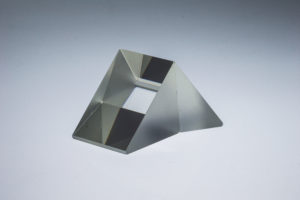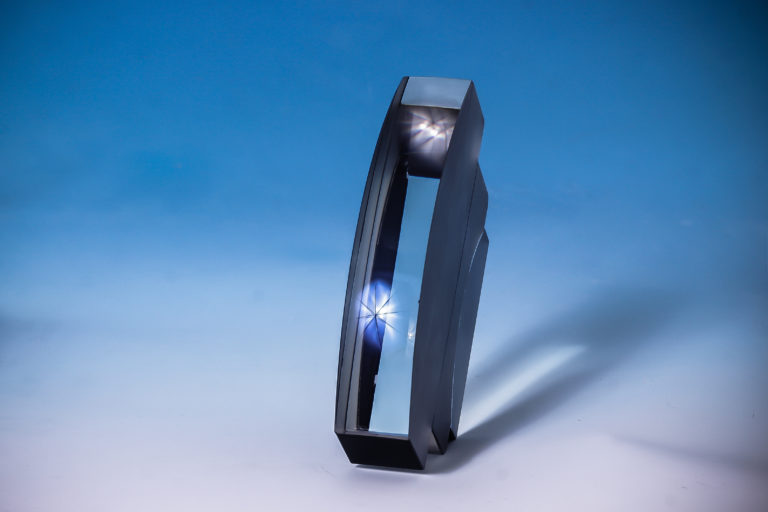Optical Bonding Techniques – Review
Published: July 20, 2020
Optical bonding is used when one needs to join two or more optical elements. In the following article we describe existing bonding techniques used in optics industry.
Bonding multiple optical components into a single optical system with no extra fixturing is essential for modern systems and apparatuses where high performance and slick form factor are essential. Since their first appearance in the 19th century, bonded components have made it possible to realize several breakthrough designs such as aplanatic, achromatic, or apochromatic lenses. Today they enable technology behind advancements in diverse application fields ranging from telecommunication to imaging and healthcare.

Fig. 1. Optical bonding – beamsplitter
Combining two or more optical elements into complex structures makes it possible to achieve desired optical performance without compromising on application form factor. While traditional mechanical mounting structures are bulky and complex, bonding does not add any size and weight to the system.
This article will discuss the most popular technologies for optics bonding, including state of art optical contacting used at Solaris Optics.
Adhesive Optical Bonding
Optical cements, adhesives or bonding materials are a traditional method for permanent bonding of optics. The method involves joining lenses or prisms with a thin layer of optical cement or adhesive. In the first step, optical cement is applied on the lens surface and the involved optics are precisely adjusted. The next step is the curing process that turns cement from liquid to a solid form and removes any residual gasses.
Based on the type of cement, the curing can depend on elevated temperature, UV exposure, or simply time. Advancements in this area have led to the widespread use of high efficient UV-curable cements that reduce pre-cure times to about an hour, compared to days required for curing through exposure to heat. This makes the centering of the elements much easier and ensures higher productivity.
Cement Bonding Engineering
The market is filled with different types of adhesive materials for optics, but the number of choices sometimes can be overwhelming and there is no one size fits all. Engineers need to balance properties and performance goals to meet the specifics of the target application. First of all, the ideal candidate should have low coefficient of thermal expansion (CTE), as the CTE difference between the joined elements is usually accommodated by the adhesive. Other criteria are broad and many, including properties and design of the joined optics, environmental considerations, production volume, and expected service life. Not to mention that cements are part of the optical train and thus should provide index and transmission homogeneity over the desired wavelength.
Manufacturability of Adhesive Bonded Elements
Avoiding bond failures requires skills and experience in performing the process. Adhesive and cement bonding processes come with many variables that may impact the connection robustness. Those include state and cleanliness of the joined surfaces, characteristics of the involved optical materials, the quality and type of cement, the conditions during the bonding and curing process. One of the main types of risks is an adhesive failure, which might result from the wrong choice of cement type or poor manufacturing process. For example, low quality of UV-light illumination leads to inhomogeneous curing of the cement, leaving uncured areas that are prone to delamination. Similarly, moisture or contamination on the surface may also lead to failure, hence the elements are cleaned and tempered before the bonding.

Fig. 2. Optical contact bonding – beamsplitters
Advantages and Limitations of Adhesive Bonding
Adhesive bonding has the advantage of high strength to meet the shock and vibration requirements of even the most demanding operating conditions. The use of cements is well established in a range of applications thanks to its proven reliability and ease of manufacturing. However, the method is not free from limitations. Optical cements have lower laser-induced damage threshold compared to optical materials, which means in case of medium- to high-power laser applications the cement becomes the critical part of the system. The extra layer can also cause scattering and absorptive losses in the system.
New Alternatives of Optical Bonding
Overcoming challenges of cementing, novel techniques were introduced for optics bonding that eliminate the need for bonding agents. The list includes diffusion bonding, thermal annealing, frit bonding, and more. While yielding strong and durable bonds, they usually require involved components to be heated and thus reduce available combinations of joined materials to matching CTEs.
Laser Welding of Optics
One alternative free of this limitation is laser welding, which uses femtoseconds laser pulses at high repetition rates to permanently join optical components. The laser light is focused on the contact zone and due to nonlinear absorption processes the material of both involved parts is melt and mixed. The resolidification of the material creates a strong and durable bond between the components. The heated zone in the sample is usually up to few millimeters thick so no considerable thermal stress is generated. The choice of bonded materials is greatly flexible as no strict CTE match is required.
Welding eliminates the need for additional bonding material while ensuring high strength and durability of the connection. However, success depends on several factors. The joined surfaces have to be extremely matched as to avoid any air gaps between the elements. Not conforming to this requirement increases the risk of interference patterns within the gaps. The process should be performed under strictly controlled conditions, as to avoid overheating or improper cooling can lead to local material stresses or deformation in the contact zone, affecting the performance of the system.
Optical Contact Bonding – Towards High-performance
Optical contact bonding is a join method without any additional cement. When the form deviation between the joined components is smaller than one nanometer and all air is removed from the interface, the bonding of the surfaces occurs solely through physical and intermolecular adhesion. Optical contact bonding is performed under strict clean conditions to avoid any particles, moisture, or chemical contamination on the surfaces. The joined surfaces are physically and chemically prepared for the process, especially in terms of roughness control.

Fig. 3. Optical contact bonding
Contact bonding for optics was first demonstrated at the end of the 19th century, but it took decades of development to adapt it to industrial production. The technique has been subject to extensive research in recent years which led to considerable advancements in connection strength and resilience to stress. With a proven track record of creating bonds as strong as if the structure was a homogeneous piece, the method is quickly gaining in popularity. The availability of industrial processing equipment that provides efficient and repeatable bonding has lowered the cost and made it affordable in a range of areas.
Contact Bonding Advantages and Applications
From the optical performance perspective, contact bonding has several advantages over competing solutions. In contrary to using optical cements or adhesives, optical contacting method does not introduce any additional elements or losses in the optical train. The interface is optically transparent and can withstand high powers. Unlike adhesive bonding, it performs well in high temperatures or when subjected to chemical exposure.
Optical contact bonding finds its use in applications where precision and ability to handle high powers are required. This includes high-power laser optics, space optics, micro-optics, and much more. For example, the method was applied in the production of large image slicer for Multi Unit Spectroscopic Explorer, an integral field spectrograph at the Very Large Telescope (VLT) operated by European Southern Observatory (ESO).
The technique of optical contact bonding is one of Solaris Optics’ several niche in-house manufacturing capabilities.
Should you have questions regarding your application of optical bonding techniques, please do not hesitate to get in touch with us!
***

